Sophorolipid-Based Oligomers as Polyol Components for Polyurethane Systems
Abstract
1. Introduction
2. Materials and Methods
2.1. Materials
2.2. Measurements and Equipment
2.3. Synthesis of 17-Hydroxyoctadec-9-Ene Acid ((ω-1) HFA)
2.4. Synthesis of (ω-1) HFA Based Polyester Diol
2.5. 12-Hydroxystearic Acid Based Polyesterdiol
2.6. Synthesis of 17-Hydroxyoctadec-9-Enoyl Azide ((ω-1) HFA Azide)
2.7. Preparation of Urethanes
2.7.1. LSL and PBA-Based Urethanes
2.7.2. Synthesis of PU Based on (ω-1) HFA-Based Polyesterdiol and 12-Hydroxystearic Acid Based Polyesterdiol
2.7.3. Preparation of A/B Type PU
2.7.4. Ternary Urethane Systems
3. Results and Discussion
3.1. Sophorolipids as Polyol Component for PU Systems
3.1.1. Solubility Studies
3.1.2. Reaction of LSL with Monoisocyanates
3.1.3. Reaction of LSL with Diisocyanates
Stoichiometric Influence
Kinetic Investigations
Behavior of Ternary Systems
3.2. (ω-1) HFA from LSL as Polyol Component for PU Systems
3.2.1. (ω-1) HFA-Based Polyester Polyols and PU Systems Thereof
3.2.2. Direct Conversion of (ω-1) HFA to PU by Curtius Rearrangement
4. Conclusions
Author Contributions
Funding
Acknowledgments
Conflicts of Interest
References
- Bayer, O. Das Di-Isocyanat-Polyadditionsverfahren (Polyurethane). Angew. Chem. 1947, 59, 257–272. [Google Scholar] [CrossRef]
- Bayer, O.; Rinke, H.; Siefken, W. Verfahren zur Herstellung von Polyurethanen bzw. Polyharnstoffen. German Patent DE728981C, 13 November 1937. [Google Scholar]
- Oertel, G.; Becker, G.W.; Braun, D. (Eds.) Polyurethane, 3rd ed.; Hanser: München, Germany, 1993; ISBN 3446162631. [Google Scholar]
- Brereton, G.; Emanuel, R.M.; Lomax, R.; Pennington, K.; Ryan, T.; Tebbe, H.; Timm, M.; Ware, P.; Winkler, K.; Yuan, T.; et al. Polyurethanes. In Ullmann’s Encyclopedia of Industrial Chemistry; Wiley-VCH Verlag GmbH & Co. KGaA: Weinheim, Germany, 2000; pp. 1–76. ISBN 9783527306732. [Google Scholar]
- Meier-Westhues, U.; Danielmeier, K.; Kruppa, P.; Squiller, E. Polyurethanes: Coatings, Adhesives and Sealants, 2nd ed.; Vincentz Network: Hannover, Germany, 2019; ISBN 3866307829. [Google Scholar]
- Müller, B.; Rath, W. Formulierung von Kleb- und Dichtstoffen: Das kompetente Lehrbuch für Studium und Praxis, 2nd ed.; Vincentz Network: Hannover, Germany, 2009; ISBN 9783866308626. [Google Scholar]
- Yilgör, I.; Yilgör, E.; Wilkes, G.L. Critical parameters in designing segmented polyurethanes and their effect on morphology and properties: A comprehensive review. Polymer 2015, 58, A1–A36. [Google Scholar] [CrossRef]
- Ionescu, M. Chemistry and Technology of Polyols for Polyurethanes; Rapra Technology Ltd: Shawbury, UK, 2005; ISBN 9781847350350. [Google Scholar]
- Bundesministerium für Ernährung und Landwirtschaft. Neue Produkte: Aus Natur gemacht—Nachwachsende Rohstoffe im Alltag; Bundesministerium für Ernährung und Landwirtschaft: Berlin, Germany, 2018. [Google Scholar]
- Athawale, V.D.; Nimbalkar, R.V. Polyurethane Dispersions Based on Sardine Fish Oil, Soybean Oil, and Their Interesterification Products. J. Dispers. Sci. Technol. 2011, 32, 1014–1022. [Google Scholar] [CrossRef]
- Azam Ali, M.; Ooi, T.L.; Salmiah, A.; Ishiaku, U.S.; Ishak, Z. New polyester acrylate resins from palm oil for wood coating application. J. Appl. Polym. Sci. 2001, 79, 2156–2163. [Google Scholar] [CrossRef]
- Brister, E.H.; Johnston, T.; King, C.L.; Thames, S.F. New Monomers from Vegetable Oils. In Specialty Monomers and Polymers; Havelka, K.O., Mc Cormick, C.L., Eds.; ACS Symposium Series; American Chemical Society: Washington, DC, USA, 2000; Volume 755, pp. 159–169. [Google Scholar]
- Bunker, S.P.; Wool, R.P. Synthesis and characterization of monomers and polymers for adhesives from methyl oleate. J. Polym. Sci. A Polym. Chem. 2002, 40, 451–458. [Google Scholar] [CrossRef]
- Cramail, H.; Boyer, A.; Epoune Lingome, C.; Alfos, C.; Gadenne, B.; Cloutet, E.; Queneau, Y.; Moebs, S. Preparation of Polyurethanes and Polyesters from Glycolipid Type Compounds. U.S. Patent 20140235814, 2 October 2012. [Google Scholar]
- Homan, J.G.; Yu, X.-H.; Connor, T.J.; Cooper, S.L. Castor oil based UV-curable polyurethane-acrylate interpenetrating networks. J. Appl. Polym. Sci. 1991, 43, 2249–2257. [Google Scholar] [CrossRef]
- Kalita, H.; Kalita, D.; Alam, S.; Chernykh, A.; Tarnavchyk, I.; Bahr, J.; Samanta, S.; Jayasooriyama, A.; Fernando, S.; Selvakumar, S.; et al. Novel Biobased Polymers for Coating Applications. In Biobased and Environmental Benign Coatings; Tiwari, A., Galanis, A., Soucek, M.D., Eds.; Scrivener Publishing: Hoboken, NJ, USA; John Wiley & Sons: Salem, MA, USA, 2016; pp. 1–16. ISBN 9781119185055. [Google Scholar]
- Noreen, A.; Zia, K.M.; Zuber, M.; Tabasum, S.; Zahoor, A.F. Bio-based polyurethane: An efficient and environment friendly coating systems: A review. Prog. Org. Coat. 2016, 91, 25–32. [Google Scholar] [CrossRef]
- Tiwari, A.; Galanis, A.; Soucek, M.D. (Eds.) Biobased and Environmental Benign Coatings; Scrivener Publishing: Hoboken, NJ, USA; John Wiley & Sons: Salem, MA, USA, 2016; ISBN 9781119185055. [Google Scholar]
- Bollmann, T.; Zerhusen, C.; Glüsen, B.; Schörken, U. Structures and Properties of Sophorolipids in Dependence of Microbial Strain, Lipid Substrate and Post-Modification. Tenside Surfactants Deterg. 2019, 56, 367–377. [Google Scholar] [CrossRef]
- Daniel, H.-J.; Reuss, M.; Syldatk, C. Production of sophorolipids in high concentration from deproteinized whey and rapeseed oil in a two stage fed batch process using Candida bombicola ATCC 22214 and Cryptococcus curvatus ATCC 20509. Biotechnol. Lett. 1998, 20, 1153–1156. [Google Scholar] [CrossRef]
- Develter, D.W.G.; Lauryssen, L.M.L. Properties and industrial applications of sophorolipids. Eur. J. Lipid Sci. Technol. 2010, 112, 628–638. [Google Scholar] [CrossRef]
- Dolman, B.M.; Kaisermann, C.; Martin, P.J.; Winterburn, J.B. Integrated sophorolipid production and gravity separation. Process Biochem. 2017, 54, 162–171. [Google Scholar] [CrossRef]
- Konishi, M.; Fukuoka, T.; Morita, T.; Imura, T.; Kitamoto, D. Production of new types of sophorolipids by Candida batistae. J. Oleo Sci. 2008, 57, 359–369. [Google Scholar] [CrossRef]
- Price, N.P.J.; Ray, K.J.; Vermillion, K.E.; Dunlap, C.A.; Kurtzman, C.P. Structural characterization of novel sophorolipid biosurfactants from a newly identified species of Candida yeast. Carbohydr. Res. 2012, 348, 33–41. [Google Scholar] [CrossRef] [PubMed]
- Zerhusen, C.; Brotsmann, J.; Barbe, S.; Schörken, U. Process optimization concepts for cost-efficient production of sophorolipids. Chem. Ing. Tech. 2018, 90, 1273. [Google Scholar] [CrossRef]
- Rau, U.; Hammen, S.; Heckmann, R.; Wray, V.; Lang, S. Sophorolipids: A source for novel compounds. Ind. Crop. Prod. 2001, 13, 85–92. [Google Scholar] [CrossRef]
- Zerhusen, C.; Bollmann, T.; Gödderz, A.; Fleischer, P.; Glüsen, B.; Schörken, U. Microbial Synthesis of Nonionic Long-Chain Sophorolipid Emulsifiers Obtained from Fatty Alcohol and Mixed Lipid Feeding. Eur. J. Lipid Sci. Technol. 2020, 122, 1900110. [Google Scholar] [CrossRef]
- Kurtzman, C.P.; Price, N.P.J.; Ray, K.J.; Kuo, T.-M. Production of sophorolipid biosurfactants by multiple species of the Starmerella (Candida) bombicola yeast clade. FEMS Microbiol. Lett. 2010, 311, 140–146. [Google Scholar] [CrossRef] [PubMed]
- Delbeke, E.I.P.; Everaert, J.; Uitterhaegen, E.; Verweire, S.; Verlee, A.; Talou, T.; Soetaert, W.; van Bogaert, I.N.A.; Stevens, C.V. Petroselinic acid purification and its use for the fermentation of new sophorolipids. AMB Express 2016, 6, 28. [Google Scholar] [CrossRef]
- Ashby, R.D.; Solaiman, D.K.Y.; Foglia, T.A. Property control of sophorolipids: Influence of fatty acid substrate and blending. Biotechnol. Lett. 2008, 30, 1093–1100. [Google Scholar] [CrossRef]
- Delbeke, E.I.P.; Movsisyan, M.; van Geem, K.M.; Stevens, C.V. Chemical and enzymatic modification of sophorolipids. Green Chem. 2016, 18, 76–104. [Google Scholar] [CrossRef]
- Boyer, A.; Lingome, C.E.; Condassamy, O.; Schappacher, M.; Moebs-Sanchez, S.; Queneau, Y.; Gadenne, B.; Alfos, C.; Cramail, H. Glycolipids as a source of polyols for the design of original linear and cross-linked polyurethanes. Polym. Chem. 2013, 4, 296–306. [Google Scholar] [CrossRef]
- Becker, H.G.O.; Beckert, R. Organikum: Organisch-Chemisches Grundpraktikum, 24th ed.; Wiley-VCH Verlag GmbH & Co. KGaA: Weinheim, Germany, 2015; ISBN 352733968X. [Google Scholar]
- Wissman, H.G.; Rand, L.; Frisch, K.C. Kinetics of polyether polyols–diisocyanate reactions. J. Appl. Polym. Sci. 1964, 8, 2971–2978. [Google Scholar] [CrossRef]
- Rand, L.; Thir, B.; Reegen, S.L.; Frisch, K.C. Kinetics of alcohol–isocyanate reactions with metal catalysts. J. Appl. Polym. Sci. 1965, 9, 1787–1795. [Google Scholar] [CrossRef]
- Entelis, S.G.; Nesterov, O.V. Kinetiks and Mechanism of the Reactions of Isocyanates with Compounds Containing “Active” Hydrogen. Russ. Chem. Rev. 1966, 35, 917–930. [Google Scholar] [CrossRef]
- Thiele, L. Kinetik der unkatalysierten Urethanbildung. Monatsh. Chem. Mon. Chem. Chem. Mon. 1992, 123, 865–874. [Google Scholar] [CrossRef]
- Wenning, C.; Schmidt, A.M.; Leimenstoll, M.C. Evolution of Reaction-Induced Phase Segregations in Bi-Soft Segment Urethane Oligomers. Macromol. Chem. Phys. 2020, 221, 1900458. [Google Scholar] [CrossRef]
- Sugihara, J.M. Relative Reactivities of Hydroxyl Groups of Carbohydrates. In Advances in Carbohydrate Chemistry; Hudson, C.S., Wolfrom, M.L., Eds.; Academic Press: New York, NY, USA, 1953; pp. 1–44. ISBN 9780120072088. [Google Scholar]
- Kurita, K.; Hirakawa, N.; Iwakura, Y. ynthetic polymers containing sugar residues, 1. Direct addition polymerization of D-glucosamine and diisocyanates. Makromol. Chem. 1977, 178, 2939–2941. [Google Scholar] [CrossRef]
- Kurita, K.; Hirakawa, N.; Iwakura, Y. Synthetic polymers containing sugar residues, 2†. Synthesis and properties of poly(urea-urethane)s derived from D-glucosamine and diisocyanates. Makromol. Chem. 1979, 180, 2331–2340. [Google Scholar] [CrossRef]
- Kurita, K.; Hirakawa, N.; Iwakura, Y. Synthetic polymers containing sugar residues, 3. Direct addition polymerization of D-cellobiose and diisocyanates to form novel polyurethanes. Makromol. Chem. 1979, 180, 855–858. [Google Scholar] [CrossRef]
- Kurita, K.; Hirakawa, N.; Morinaga, H.; Iwakura, Y. Synthetic polymers containing sugar residues, 6. Novel polyurethanes by direct addition polymerization of α,α-trehalose with diisocyanates. Makromol. Chem. 1979, 180, 2769–2773. [Google Scholar] [CrossRef]
- Stockmayer, W.H. Molecular distribution in condensation polymers. J. Polym. Sci. 1952, 9, 69–71. [Google Scholar] [CrossRef]
- Fogiel, A.W. Effective Functionality and Intramolecular Reactions of Polyisocyanates and Polyols. Macromolecules 1969, 2, 581–587. [Google Scholar] [CrossRef]
- Yang, W.T.; Deng, J.Y.; Jin, G.T. A new gelation theory. Polym. Bull. 1994, 33, 733–740. [Google Scholar] [CrossRef]
- Dieterich, V.D.; Reiff, H. Polyurethan-dispersionen durch schmelz-dispergierverfahren. Angew. Makromol. Chem. 1972, 26, 85–106. [Google Scholar] [CrossRef]
- Dieterich, D. Neuere wäßrige PUR-Systeme. Angew. Makromol. Chem. 1981, 98, 133–165. [Google Scholar] [CrossRef]
- Dieterich, D. Aqueous emulsions, dispersions and solutions of polyurethanes; synthesis and properties. Prog. Org. Coat. 1981, 9, 281–340. [Google Scholar] [CrossRef]
- Mutlu, H.; Meier, M.A.R. Castor oil as a renewable resource for the chemical industry. Eur. J. Lipid Sci. Technol. 2010, 112, 10–30. [Google Scholar] [CrossRef]
- Palaskar, D.V.; Boyer, A.; Cloutet, E.; Alfos, C.; Cramail, H. Synthesis of biobased polyurethane from oleic and ricinoleic acids as the renewable resources via the AB-type self-condensation approach. Biomacromolecules 2010, 11, 1202–1211. [Google Scholar] [CrossRef]
- Petrović, Z.S.; Cvetković, I.; Hong, D.; Wan, X.; Zhang, W.; Abraham, T.; Malsam, J. Polyester polyols and polyurethanes from ricinoleic acid. J. Appl. Polym. Sci. 2008, 108, 1184–1190. [Google Scholar] [CrossRef]
- Radi, B.; Wellard, R.M.; George, G.A. Effect of dangling chains on the structure and physical properties of a tightly crosslinked poly(ethylene glycol) network. Soft Matter 2013, 9, 3262. [Google Scholar] [CrossRef]
- Herlinger, H.; Müller, P.; Müller-Dolezal, H.; Stoltz, R.; Söll, H. (Eds.) Houben-Weyl Methods of Organic Chemistry: Macromolecular Compounds II; Georg Thieme Verlag: Stuttgart, Germany, 2014; ISBN 9783131810540. [Google Scholar]
- Gubbels, E.; Heitz, T.; Yamamoto, M.; Chilekar, V.; Zarbakhsh, S.; Gepraegs, M.; Köpnick, H.; Schmidt, M.; Brügging, W.; Rüter, J.; et al. Polyesters. In Ullmann’s Encyclopedia of Industrial Chemistry; Wiley-VCH Verlag GmbH & Co. KGaA: Weinheim, Germany, 2000; pp. 1–30. ISBN 9783527306732. [Google Scholar]
- Kobayashi, S. Lipase-catalyzed polyester synthesis—A green polymer chemistry. Proc. Jpn. Acad. Ser. B 2010, 86, 338–365. [Google Scholar] [CrossRef]
- Kobayashi, S.; Uyama, H.; Kimura, S. Enzymatic Polymerization. Chem. Rev. 2001, 101, 3793–3818. [Google Scholar] [CrossRef]
- Gross, R.A.; Kumar, A.; Kalra, B. Polymer Synthesis by In Vitro Enzyme Catalysis. Chem. Rev. 2001, 101, 2097–2124. [Google Scholar] [CrossRef]
- Douka, A.; Vouyiouka, S.; Papaspyridi, L.-M.; Papaspyrides, C.D. A review on enzymatic polymerization to produce polycondensation polymers: The case of aliphatic polyesters, polyamides and polyesteramides. Prog. Polym. Sci. 2018, 79, 1–25. [Google Scholar] [CrossRef]
- Ortiz, C.; Ferreira, M.L.; Barbosa, O.; dos Santos, J.C.S.; Rodrigues, R.C.; Berenguer-Murcia, Á.; Briand, L.E.; Fernandez-Lafuente, R. Novozym 435: The “perfect” lipase immobilized biocatalyst? Catal. Sci. Technol. 2019, 9, 2380–2420. [Google Scholar] [CrossRef]
- Nefzger, H.; Bauer, E.; Klesczewski, B.; Schlossmacher, J.; Mayer-Ahrens, S.; Schmidt, M. Method for Producing Flexible Polyurethane Foams. World Patent 2012/069386, 18 November 2011. [Google Scholar]
- Smith, P.A.S. The Curtius Reaction. Org. React. 1946, 3, 337–449. [Google Scholar] [CrossRef]
- Stoermer, R. Umlagerung aromatischer Säureazide in Arylisocyanate. Ber. Dtsch. Chem. Ges. 1909, 42, 3133–3134. [Google Scholar] [CrossRef]
- Kinstle, J.F.; Sepulveda, L.E. A novel “apparent sublimation” of a polymer. J. Polym. Sci. B Polym. Lett. Ed. 1977, 15, 467–469. [Google Scholar] [CrossRef]
- Ghatge, N.D.; Jadhav, J.Y. Synthesis, characterization, and properties of novel poly(ether urethanes). J. Polym. Sci. Polym. Chem. Ed. 1983, 21, 1941–1950. [Google Scholar] [CrossRef]
- Kumar, A.; Ramakrishnan, S. A novel one-pot synthesis of hyperbranched polyurethanes. J. Chem. Soc. Chem. Commun. 1993, 1453. [Google Scholar] [CrossRef]
- Kumar, A.; Ramakrishnan, S. Hyperbranched polyurethanes with varying spacer segments between the branching points. J. Polym. Sci. A Polym. Chem. 1996, 34, 839–848. [Google Scholar] [CrossRef]
- Ranganathan, T.; Ramesh, C.; Kumar, A. Synthesis of new thermotropic liquid crystalline polyurethanes containing biphenyl mesogens using a novel AB-type self-polycondensation. Chem. Commun. 2004, 154–155. [Google Scholar] [CrossRef] [PubMed]
- More, A.S.; Gadenne, B.; Alfos, C.; Cramail, H. AB type polyaddition route to thermoplastic polyurethanes from fatty acid derivatives. Polym. Chem. 2012, 3, 1594. [Google Scholar] [CrossRef]
- Armarego, W.L.F.; Chai, C.L.L. Purification of Laboratory Chemicals, 6th ed.; Elsevier/BH: Oxford, UK, 2009; ISBN 0080878245. [Google Scholar]
- Gorin, P.A.J.; Spencer, J.F.T.; Tulloch, A.P. Hydroxy Fatty Acid Glycosides of Sophorose from Torulopsis Magnioliae. Can. J. Chem. 1961, 39, 846–855. [Google Scholar] [CrossRef]
- Tale, R.H.; Patil, K.M. 3,4,5-Trifluorobenzeneboronic acid: A mild and versatile catalyst for the one-pot synthesis of acyl azides from carboxylic acids. Tetrahedron Lett. 2002, 43, 9715–9716. [Google Scholar] [CrossRef]
- Qiu, Y.; Zhang, Y.; Li, Y.; Ren, J. Discovery of Uracil Derivatives as Potent Inhibitors of Fatty Acid Amide Hydrolase. Molecules 2016, 21, 229. [Google Scholar] [CrossRef]
- Joel, D.; Müller, P.; Ahl, R. Isocyanate reactions in and with N,N-dimethylformamide. Angew. Makromol. Chem. 1992, 197, 131–139. [Google Scholar] [CrossRef]
- Weiner, M. Notes: Reaction of Phenyl Isocyanate with N,N-Dimethylformamide. J. Org. Chem. 1960, 25, 2245–2246. [Google Scholar] [CrossRef]
- Sorenson, W.R. Reaction of an Isocyanate and a Carboxylic Acid in Dimethyl Sulfoxide. J. Org. Chem. 1959, 24, 978–980. [Google Scholar] [CrossRef]
- Reichardt, C. Solvatochromic Dyes as Solvent Polarity Indicators. Chem. Rev. 1994, 94, 2319–2358. [Google Scholar] [CrossRef]
- Reichardt, C. (Ed.) Solvents and Solvent Effects in Organic Chemistry, 3rd ed.; Wiley-VCH: Weinheim, Germany, 2004; ISBN 3527306188. [Google Scholar]
- Meyer-Stork, L.S.; Höcker, H.; Berndt, H. Syntheses and reactions of urethanes of cellobiose and cellulose-containing uretdione groups. J. Appl. Polym. Sci. 1992, 44, 1043–1049. [Google Scholar] [CrossRef]
- Frisch, K.C.; Rumao, L.P. Catalysis in Isocyanate Reactions. J. Macromol. Sci. Polym. Rev. 1970, 5, 103–149. [Google Scholar] [CrossRef]
- Sonnabend, M. Sophorolipide und Deren Derivate als Biobasierte Bausteine für Polyurethansysteme; Universitäts- und Stadtbibliothek Köln: Köln, Germany, 2019. [Google Scholar]
- Delebecq, E.; Pascault, J.-P.; Boutevin, B.; Ganachaud, F. On the versatility of urethane/urea bonds: Reversibility, blocked isocyanate, and non-isocyanate polyurethane. Chem. Rev. 2013, 113, 80–118. [Google Scholar] [CrossRef]
- Dyer, E.; Taylor, H.A.; Mason, S.J.; Samson, J. The Rates of Reaction of Isocyanates with Alcohols. I. Phenyl Isocyanate with 1- and 2-Butanol. J. Am. Chem. Soc. 1949, 71, 4106–4109. [Google Scholar] [CrossRef]
- Flory, P.J. Molecular Size Distribution in Linear Condensation Polymers 1. J. Am. Chem. Soc. 1936, 58, 1877–1885. [Google Scholar] [CrossRef]
- Eyster, E.H.; Gillette, R.H. The Vibration Spectra of Hydrazoic Acid, Methyl Azide, and Methyl Isocyanate the Thermodynamic Functions of Hydrazoic Acid. J. Chem. Phys. 1940, 8, 369–377. [Google Scholar] [CrossRef]
- Merten, V.R.; Lauerer, D.; Braun, G.; Dahm, M. Über den aufbau von polyurethan-kunststoffen. II. Die struktur von polyurethan-schaumstoffen in abhängigkeit von der temperatur, der zeit und der rezeptur; IR-spektroskopische nachweisgrenzen für urethan- und harnstoffgruppen in polymeren. Makromol. Chem. 1967, 101, 337–366. [Google Scholar] [CrossRef]
- Nakayama, K.; Ino, T.; Matsubara, I. Infrared Spectra and Structure of Polyurethane Elastomers from Polytetrahydrofuran, Diphenylmethane-4, 4′-diisocyanate, and Ethylenediamine. J. Macromol. Sci. Chem. 1969, 3, 1005–1020. [Google Scholar] [CrossRef]
- Zharkov, V.; Strikovsky, A.; Verteletskaya, T. Amide I absorption band: Description of the urethane group association scheme in polyether urethane elastomers. Polymer 1993, 34, 938–941. [Google Scholar] [CrossRef]
- Strikovsky, A.G.; Zharkov, V.V. Infra-red spectroscopy study of equilibrium association of urethane groups in poly(ether urethane)s. Polymer 1993, 34, 3397–3401. [Google Scholar] [CrossRef]
- Hoyer, H. Die Infrarotabsorption der Isocyanatgruppe. Ber. Dtsch. Chem. Ges. 1956, 89, 2677–2681. [Google Scholar] [CrossRef]
- Hirschmann, R.P.; Kniseley, R.N.; Fassel, V.A. The infrared spectra of alkyl isocyanates. Spectrochim. Acta 1965, 21, 2125–2133. [Google Scholar] [CrossRef]








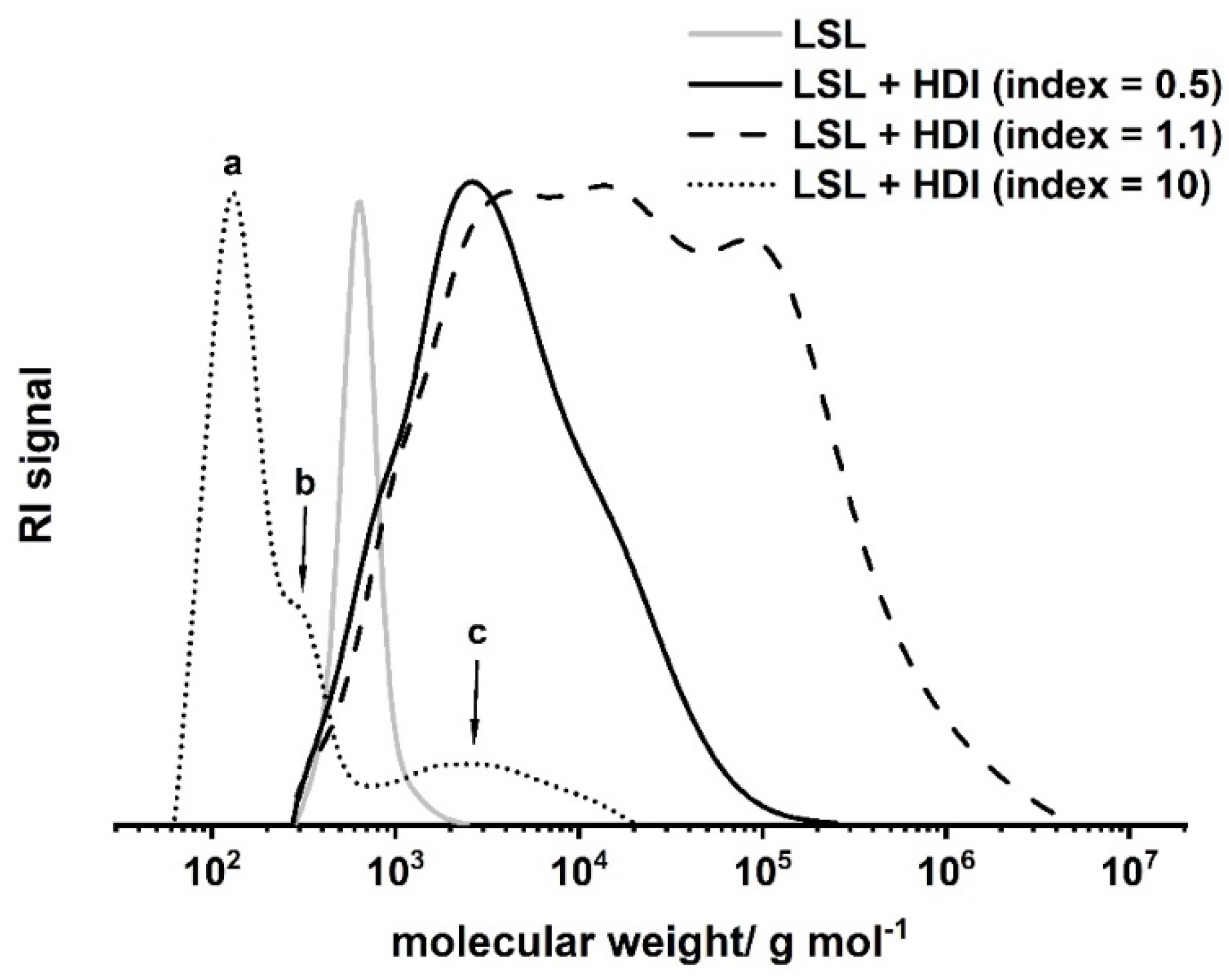

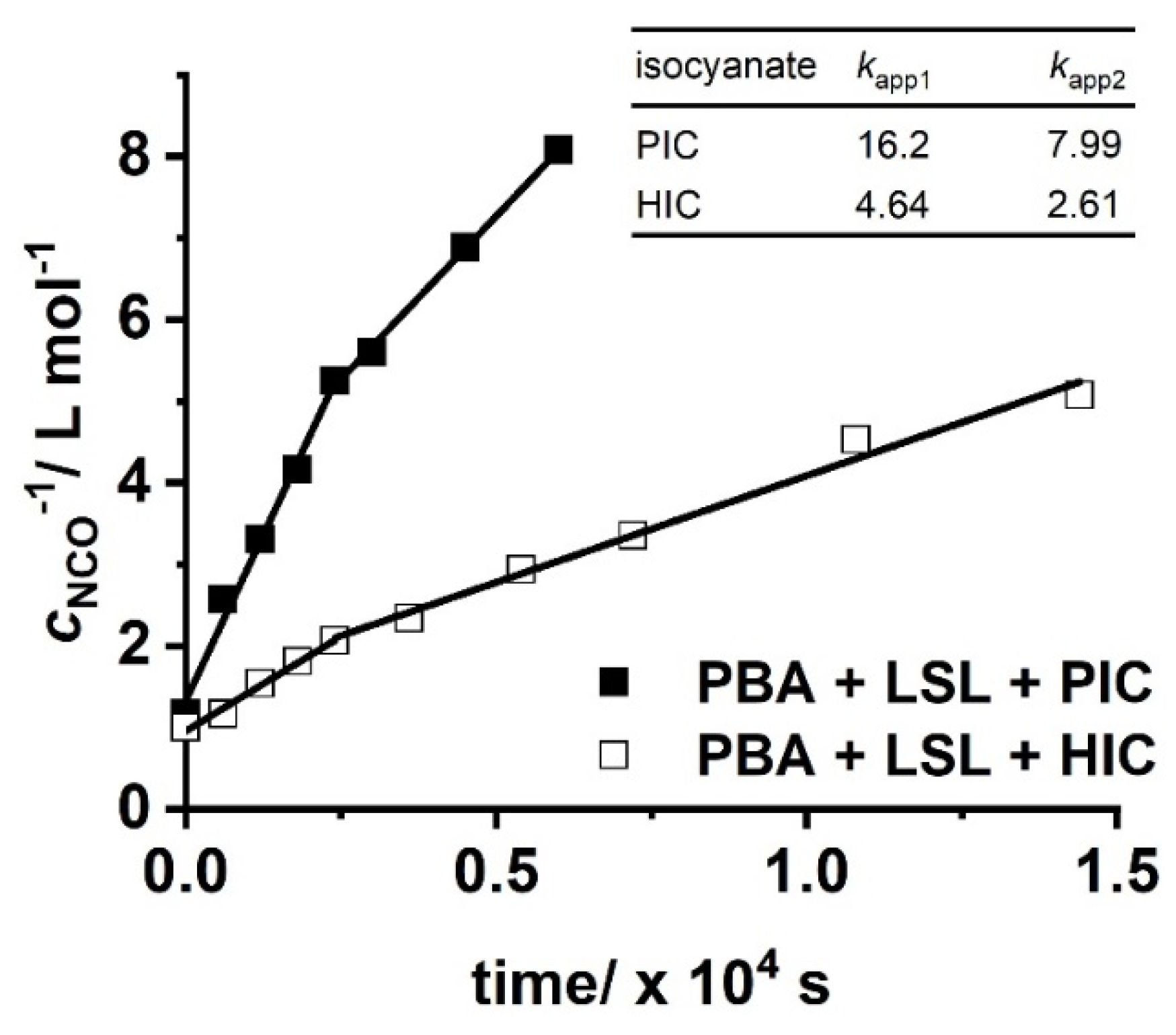

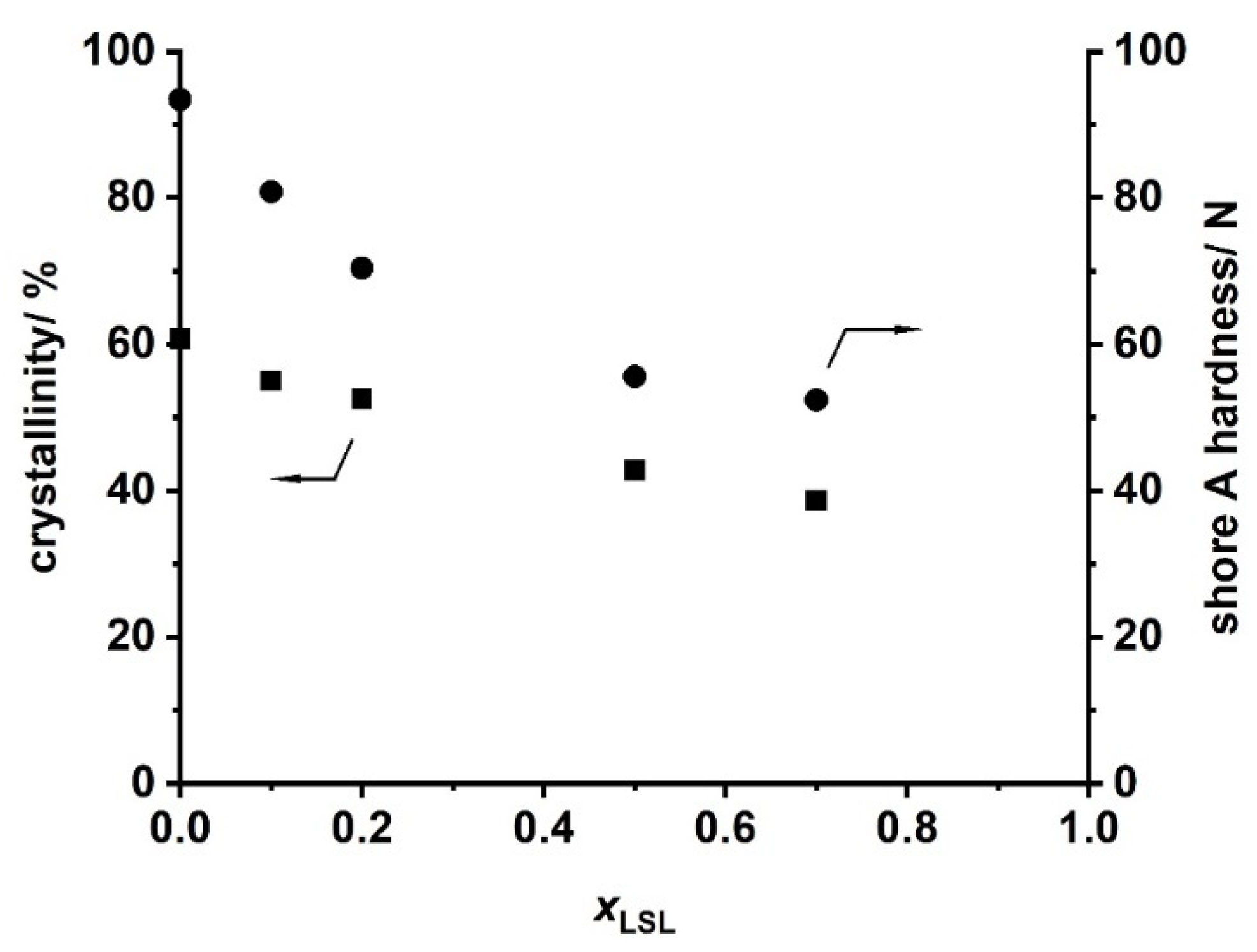
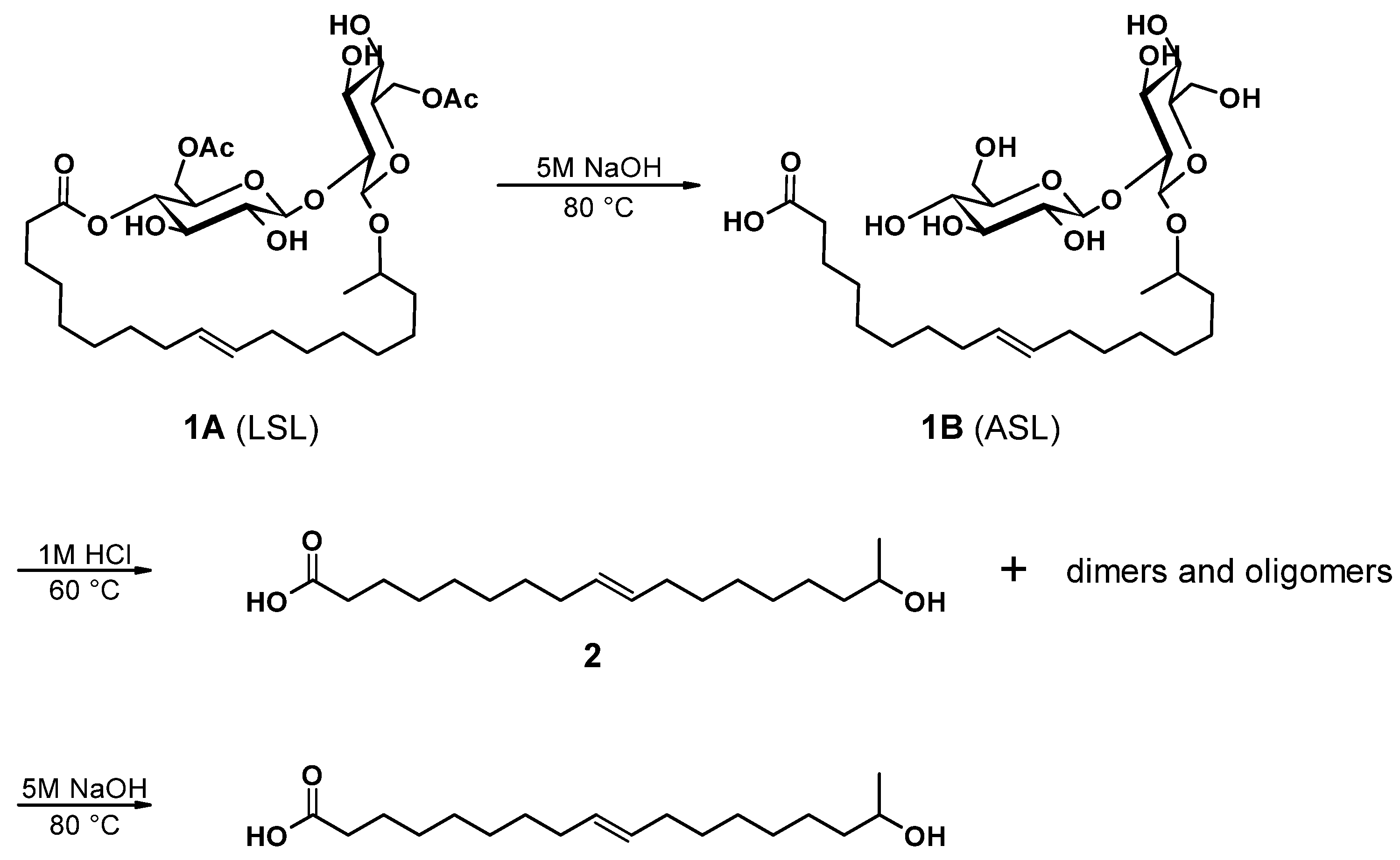

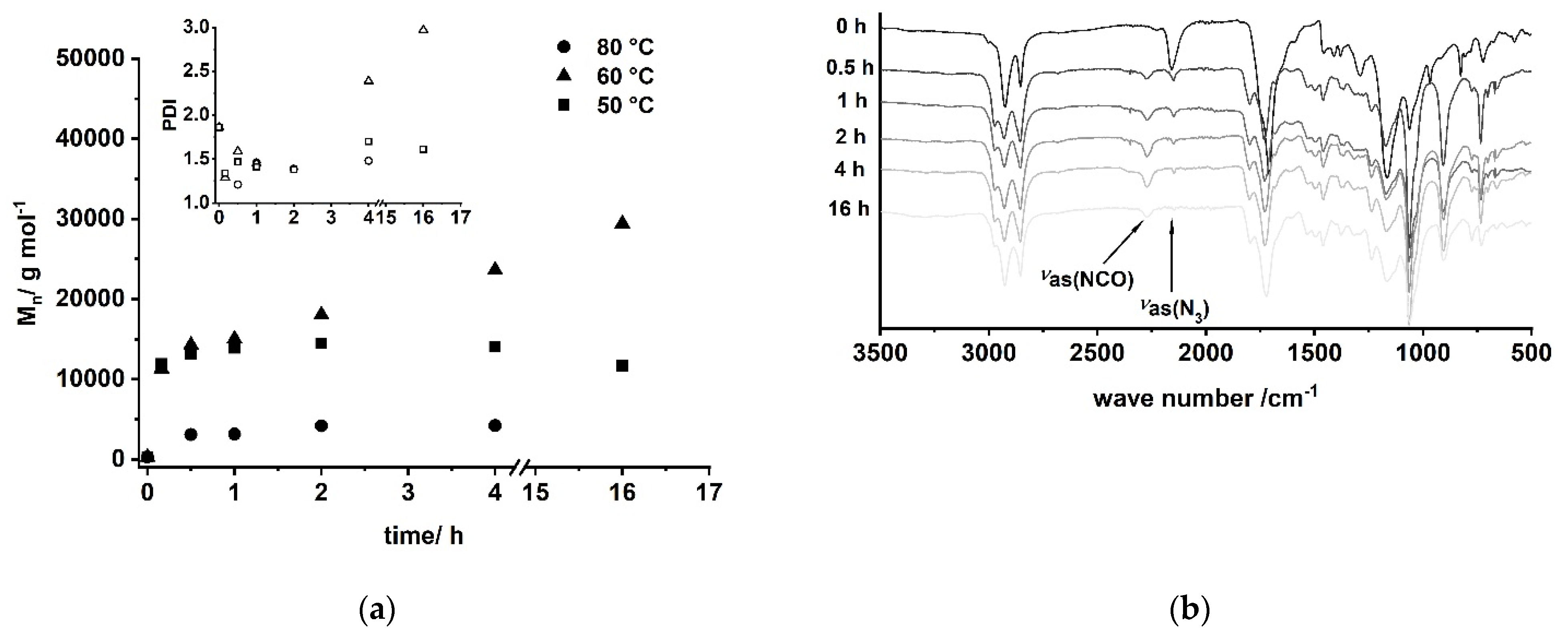
| Sample | Polyol | Isocyanate | nNCO/mol | nNCO/nOH | cDBTDL/ppm 1 | T/°C |
|---|---|---|---|---|---|---|
| LSL−HIC−S1 | LSL | HIC | 0.0317 | 1.1 | 125 | 30 |
| LSL−HIC−S2 | LSL | HIC | 0.0317 | 1.1 | 125 | 50 |
| LSL−HIC−S3 | LSL | HIC | 0.0317 | 1.1 | 500 | 50 |
| LSL−HIC−S4 | LSL | HIC | 0.0432 | 1.5 | 500 | 50 |
| LSL−PIC−S1 | LSL | PIC | 0.0317 | 1.1 | 125 | 30 |
| LSL−PIC−S2 | LSL | PIC | 0.0317 | 1.1 | 125 | 50 |
| LSL−PIC−S3 | LSL | PIC | 0.0317 | 1.1 | 500 | 50 |
| LSL−PIC-−S4 | LSL | PIC | 0.0432 | 1.5 | 500 | 50 |
| LSL−PIC−S5 | LSL | PIC | 0.1440 | 5.0 | 500 | 50 |
| LSL−HDI0.5 | LSL | HDI | 0.0072 | 0.5 | 500 | 50 |
| LSL−HDI1.1 | LSL | HDI | 0.0158 | 1.1 | 500 | 50 |
| LSL−HDI10 | LSL | HDI | 0.1440 | 10.0 | 500 | 50 |
| PBA + PIC | PBA | PIC | 0.0220 | 1.1 | 500 | 50 |
| PBA + HIC | PBA | HIC | 0.0220 | 1.1 | 500 | 50 |
| PBA + HDI | PBA | HDI | 0.0048 | 1.1 | 500 | 50 |
| Sample | xLSL | nLSL/mol | nPBA/mol | nNCO/mol | TM/°C |
|---|---|---|---|---|---|
| PBA−HDI−0%LSL | 0.0 | - | 0.0222 | 0.0110 | 47.51 |
| PBA−HDI−10%LSL | 0.1 | 0.0022 | 0.0200 | 0.0122 | 41.39 |
| PBA−HDI−20%LSL | 0.2 | 0.0050 | 0.0200 | 0.0150 | 40.65 |
| PBA−HDI−50%LSL | 0.5 | 0.0178 | 0.0178 | 0.0263 | 42.57 |
| PBA−HDI−70%LSL | 0.7 | 0.0100 | 0.0235 | 0.0285 | - |
| PBA−HDI−100%LSL | 1.0 | 0.0073 | - | 0.0073 | 46.22 1 |
| Solvent | [77,78] | Solubility LSL | Solubility ASL |
|---|---|---|---|
| Petroleum ether | − 1 | − | − |
| Cyclohexane | 0.025 | − | − |
| n-Hexane | 0.038 | − | − |
| Toluene | 0.414 | + | − |
| Diethyl ether | 0.490 | − | − |
| tert-Butyl methyl ether (MTBE) | 0.519 | − | − |
| 1,4-Dioxane | 0.687 | + | − |
| Tetrahydrofuran (THF) | 0.867 | + | − |
| Ethyl acetate | 0.955 | − | − |
| Chloroform | 1.084 | + | − |
| Dichloromethane | 1.294 | + | − |
| 2-Butanone (MEK) | 1.369 | + | − |
| Acetone | 1.486 | + | − |
| N-Methylpyrrolidin-2-one (NMP) | 1.486 | + | − |
| N,N-Dimethylformamide (DMF) | 1.616 | + | + |
| Dimethyl sulfoxide (DMSO) | 1.859 | + | + |
| Acetonitrile | 1.926 | + | − |
| 2-Propanol | 2.286 | − | − |
| Ethanol | 2.738 | − | − |
| Methanol | 3.190 | + | + |
| Water | 4.187 | + | + |
Publisher’s Note: MDPI stays neutral with regard to jurisdictional claims in published maps and institutional affiliations. |
© 2021 by the authors. Licensee MDPI, Basel, Switzerland. This article is an open access article distributed under the terms and conditions of the Creative Commons Attribution (CC BY) license (https://creativecommons.org/licenses/by/4.0/).
Share and Cite
Sonnabend, M.; Aubin, S.G.; Schmidt, A.M.; Leimenstoll, M.C. Sophorolipid-Based Oligomers as Polyol Components for Polyurethane Systems. Polymers 2021, 13, 2001. https://doi.org/10.3390/polym13122001
Sonnabend M, Aubin SG, Schmidt AM, Leimenstoll MC. Sophorolipid-Based Oligomers as Polyol Components for Polyurethane Systems. Polymers. 2021; 13(12):2001. https://doi.org/10.3390/polym13122001
Chicago/Turabian StyleSonnabend, Maresa, Suzanne G. Aubin, Annette M. Schmidt, and Marc C. Leimenstoll. 2021. "Sophorolipid-Based Oligomers as Polyol Components for Polyurethane Systems" Polymers 13, no. 12: 2001. https://doi.org/10.3390/polym13122001
APA StyleSonnabend, M., Aubin, S. G., Schmidt, A. M., & Leimenstoll, M. C. (2021). Sophorolipid-Based Oligomers as Polyol Components for Polyurethane Systems. Polymers, 13(12), 2001. https://doi.org/10.3390/polym13122001






